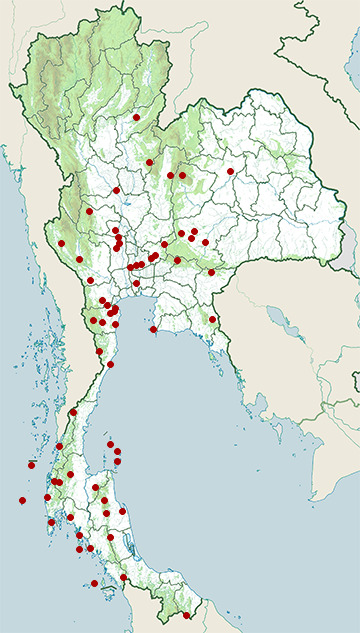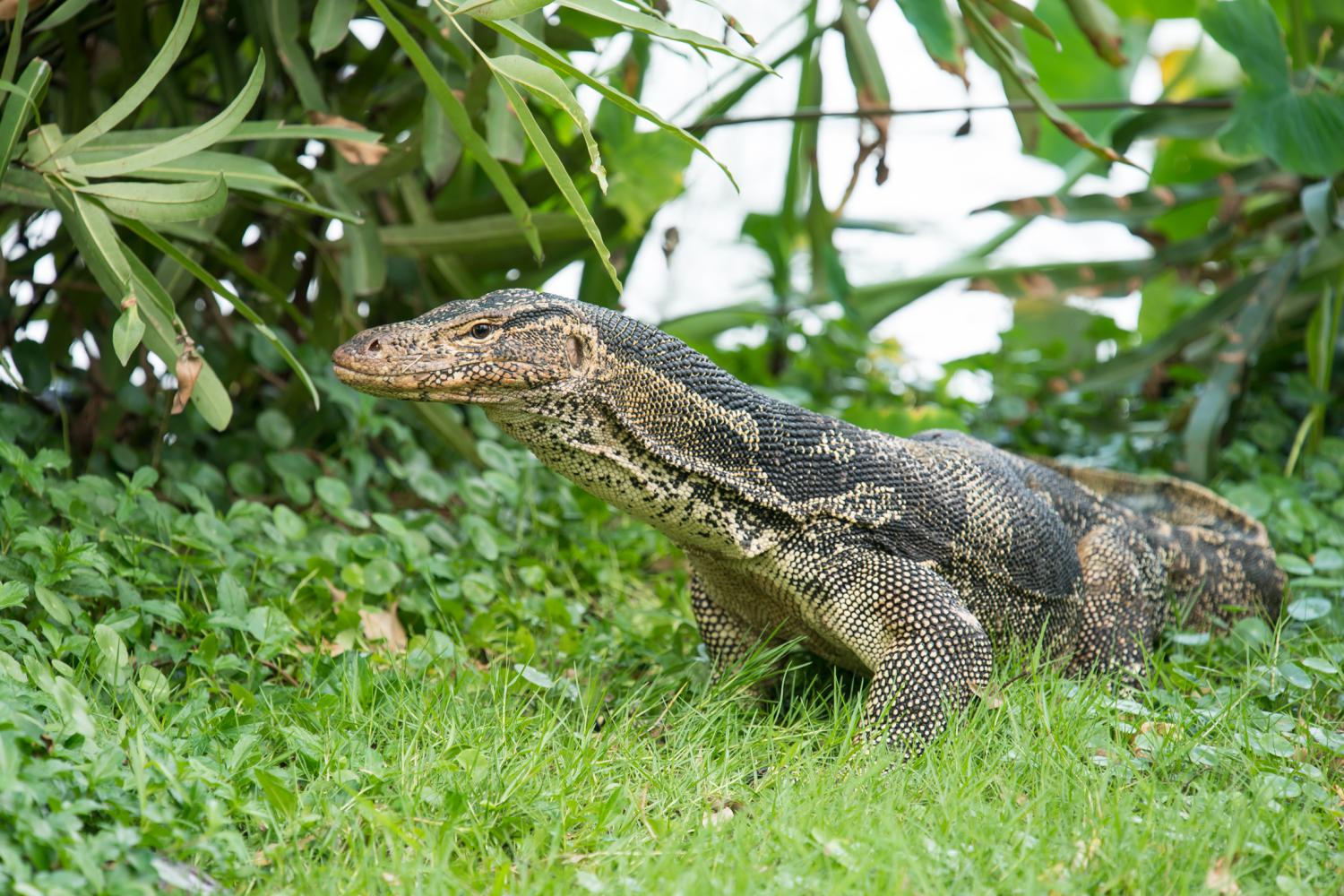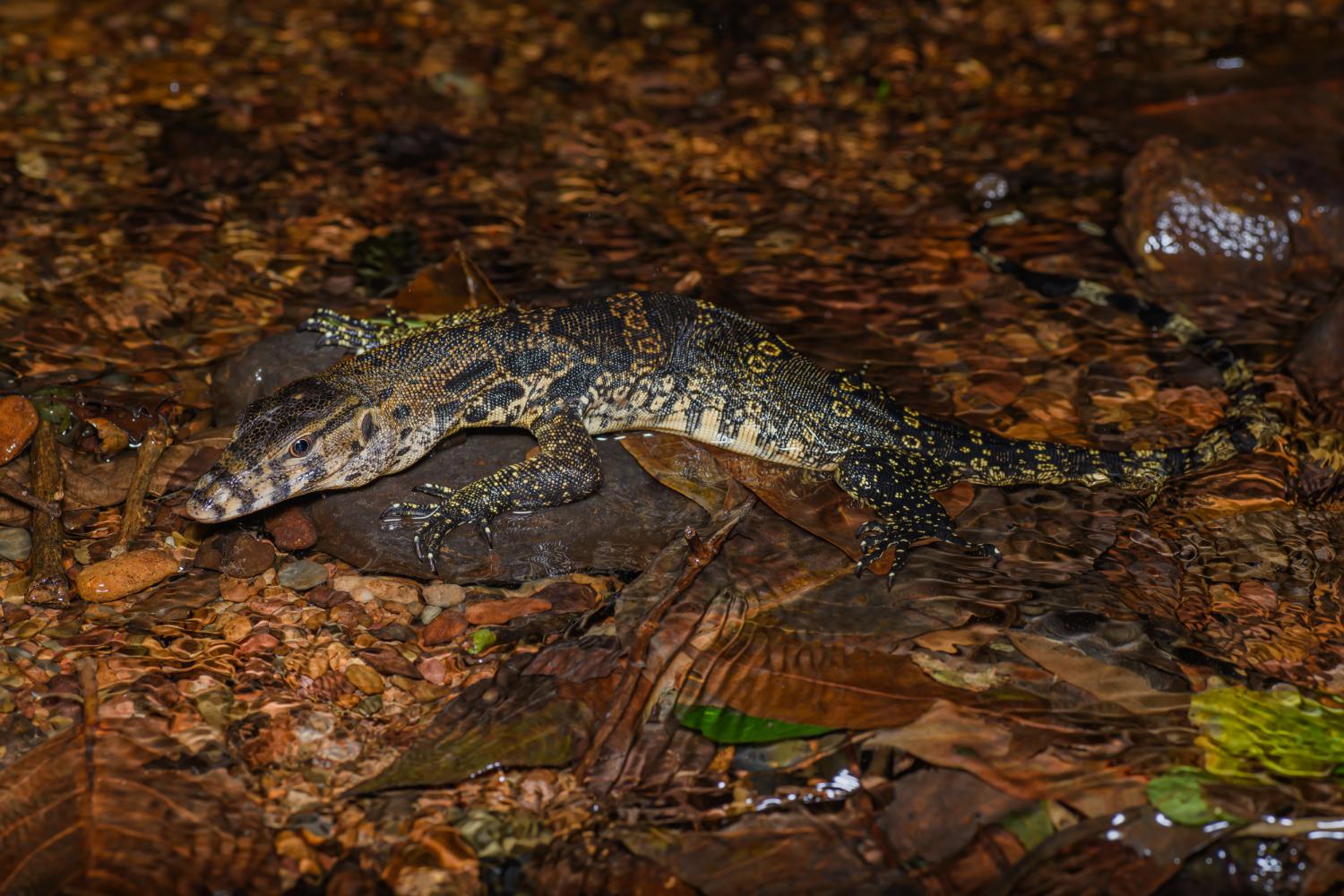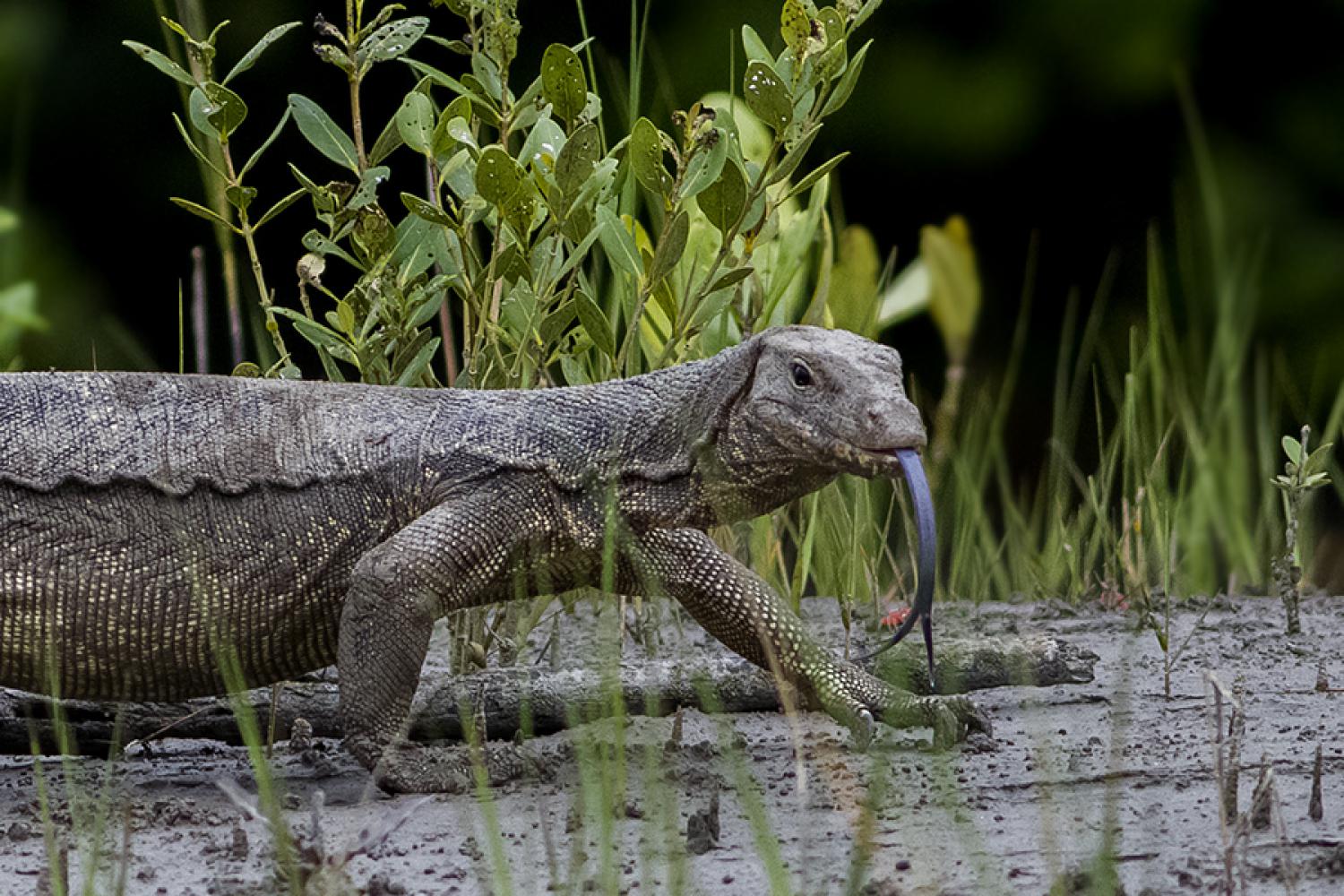Species of Thailand
Water monitor
Varanus salvator
Josephus Nicolaus Laurenti, 1768
In Thai: เหี้ย, hieya
The water monitor (Varanus salvator) is a large lizard native to South and Southeast Asia. Water monitors are one of the most common monitor lizards found throughout Asia, and range from Sri Lanka and India to Indochina, the Malay Peninsula, and various islands of Indonesia, living in areas close to water.
The species can survive where other large carnivores cannot, as they are cold-blooded (hence efficient). The species is known as Malayan water monitor, Asian water monitor, common water monitor, two-banded monitor, and as rice lizard, ring lizard, plain lizard and no-mark lizard, as well as simply "water monitor".
Description
The water monitor is a large species of monitor lizard. Breeding maturity is attained for males when they are a relatively modest 40 cm long and weigh 1 kg, and for females at 50 cm. However, they grow much larger throughout life, with males being larger than females. Adults rarely exceed 1.5 - 2 m in length, but the largest specimen on record, from Sri Lanka, measured 3.21 m. A common mature weight of V. salvator can be 19.5 kg. However, 80 males killed for the leather trade in Sumatra averaged only 3.42 kg and 56.6 cm snout-to-vent and 142 cm in total length; 42 females averaged only 3.52 kg and 59 cm snout-to-vent and 149.6 cm in total length, although unskinned outsized specimens weighed 16 to 20 kg. Another study from the same area by the same authors similarly estimated mean body mass for mature specimens at 20 kg while yet another study found a series of adults to weigh 7.6 kg. The maximum weight of the species is over 50 kg. In exceptional cases, the species has been reported to attain 75 to 90 kg, though most such reports are unverified and may be unreliable. They are the world's second-heaviest lizard, after the Komodo dragon. Their bodies are muscular, with long, powerful, laterally compressed tails.
Etymology
The generic name Varanus is derived from the Arabic waral (), which translates as "monitor". The specific name is the Latin word for "saviour", denoting a possible religious connotation. The water monitor is occasionally confused with the crocodile monitor (V. salvadorii) because of their similar scientific names.
In Thailand, the local word for a water monitor, hia (), is used as an insulting word for bad and evil things, including bad persons. The word is also thought to bring bad luck, so some people prefer to call the animals 'silver-and-gold' () to avoid the jinx.
The origin of this offensive meaning can be traced back to a time when more people lived in rural areas in close proximity to monitor lizards. Traditionally, Thai villagers lived in two-story houses; the top floor was for living, while the ground floor was designed to be a space for domestic animals such as pigs, chickens, and dogs. Water monitors would enter the ground floor and eat or maim the domestic animals, also hence the other name dtua gin gai ( ‘chicken eater’).
In Indonesian and Malay, the water monitor is called biawak air, to differentiate it from the biawak pasir ("sand lizard"), Leiolepis belliana.
Subspecies
- The Asian water monitor, V. s. salvator, the nominate subspecies, is now restricted to Sri Lanka, where it is known as the kabaragoya (කබරගොයා) in Sinhala and kalawathan in Tamil.
- The Andaman Islands water monitor, V. s. andamanensis, is found on the Andaman Islands; the type locality is Port Blair, Andaman Islands.
- The two-striped water monitor, V. s. bivittatus, is common to Java, Bali, Lombok, Sumbawa, Flores, Ombai (Alor), Wetar, and some neighbouring islands within the Sunda arch, Indonesia; the type locality is Java (designated by Mertens 1959).
- The black water monitor, V. s. komaini, from Thailand (type locality: Amphoe La-ngu, Satun Prov., Thailand, and Thai-Malaysian border area), was formerly a subspecies, but now is regarded as a synonym of V. s. macromaculatus.
- The Southeast Asian water monitor, V. s. macromaculatus (type locality: Siam is found in mainland Southeast Asia, Singapore, Sumatra, Borneo, and smaller associated offshore islands.
- Ziegler's water monitor, V. s. ziegleri, is from Obi Island.
- Varanus cumingi, Varanus marmoratus, and Varanus nuchalis were classified as subspecies until 2007, when they were elevated to full species.
Behavior and diet
Water monitors defend themselves using their tails, claws, and jaws. They are excellent swimmers, using the raised fin on their tails to steer through water. They are carnivores, and have a wide range of foods. They are known to eat fish, frogs, rodents, birds, crabs, and snakes. They have also been known to eat turtles, as well as young crocodiles and crocodile eggs. Like the Komodo dragon, they will often eat carrion. Water monitors have been observed eating catfish in a fashion similar to a mammalian carnivore, tearing off chunks of meat with their sharp teeth while holding it with their fore legs and then separating different parts of the fish for sequential consumption.
Conservation
In Nepal it is a protected species in Chitwan National Park under the Wild Animals Protection Act of 2002. In Hong Kong, it is a protected species under Wild Animals Protection Ordinance Cap 170. In Malaysia, this species is one of the most common wild animals around, with numbers comparable to that of the population of macaques there. Although many fall prey to humans via roadkill and animal cruelty, they still thrive in most states of Malaysia, especially in the shrubs of the east-coast states such as Pahang and Terengganu. In the east-coast states of Malaysia, this species is very common in roadkill. In Thailand, all monitor lizards are protected species. This monitor is exploited by the pet trade.
They are hunted for their skins, with as many as 1.5 million skins being exported per year to Europe, U.S., Japan for use in fashion goods. They are also eaten. Loss of habitat and hunting has exterminated water monitors from most of mainland India. In other areas they survive despite being hunted, in part as larger ones, including large females that breed large numbers of eggs, have tough skins that are not desirable.
In Sri Lanka, they are protected by locals who value their predation of "crabs that would otherwise undermine the banks of rice fields".
This article uses material from Wikipedia released under the Creative Commons Attribution-Share-Alike Licence 3.0. Eventual photos shown in this page may or may not be from Wikipedia, please see the license details for photos in photo by-lines.
Scientific classification
- Kingdom
- Animalia
- Phylum
- Chordata
- Class
- Reptilia
- Order
- Squamata
- Suborder
- Lacertilia
- Family
- Varanidae
- Genus
- Varanus
- Species
- Varanus salvator
Common names
- German: Bindenwaran
- English: Common water monitor
- Thai:
- เหี้ย, hieya
- แลนดอกไม้, laen dork mai
- ตัวเงินตัวทอง, tua nguen tua tong
Subspecies
Varanus salvator andamanensis, Paul E. Pieris Deraniyagala, 1944
Common name: The Andaman Islands
Range: Andaman Islands; the type locality is Port Blair, Andaman Islands.
Varanus salvator bivittatus, Heinrich Kuhl, 1820
Common name: The two-striped water monitor
Range: Common to Java, Bali, Lombok, Sumbawa, Flores, Ombai (Alor), Wetar, and some neighbouring islands within the Sunda arch, Indonesia; the type locality is Java (designated by Mertens 1959).
Varanus salvator komaini, Wirot Nutphand, 1987
Common name: The black water monitor
Range: Thailand (type locality: Amphoe La-ngu, Satun Prov., Thailand, and Thai-Malaysian border area), was formerly a subspecies, but now is regarded as a synonym of V. s. macromaculatus.
Varanus salvator macromaculatus, Paul E. Pieris Deraniyagala, 1944
Common name: The Southeast Asian water monitor
Range: Found in mainland Southeast Asia, Singapore, Sumatra, Borneo, and smaller associated offshore islands.
Varanus salvator salvator, Josephus Nicolaus Laurenti, 1768
Common name: The Asian water monitor
Range: The nominate subspecies, is now restricted to Sri Lanka, where it is known as the kabaragoya in Sinhala and kalawathan in Tamil.
Varanus salvator ziegleri, André Koch & Wolfgang Böhme, 2010
Common name: Ziegler's water monitor
Range: Obi Island
Conservation status

Least Concern (IUCN3.1)
Photos
Please help us review our species pages if wrong photos are used or any other details in the page is wrong. We can be reached via our contact us page.
Range Map

- Ban Laem District, Phetchaburi
- Ban Lat District, Phetchaburi
- Bang Pa In District, Phra Nakhon Si Ayutthaya
- Bang Sai District, Phra Nakhon Si Ayutthaya
- Bangkok Province
- Banphot Phisai District, Nakhon Sawan
- Cha-Am District, Phetchaburi
- Chet Sao Noi Waterfall National Park
- Chok Chai District, Nakhon Ratchasima
- Dan Makham Tia District, Kanchanaburi
- Doem Bang Nang Buat District, Suphan Buri
- Don Chedi District, Suphan Buri
- Erawan National Park
- Hala-Bala Wildlife Sanctuary
- Hankha District, Chainat
- Hat Chao Mai National Park
- Huai Kha Khaeng Wildlife Sanctuary
- Kaeng Krachan District, Phetchaburi
- Kaeng Krachan National Park
- Kham Thale So District, Nakhon Ratchasima
- Khao Lak - Lam Ru National Park
- Khao Luang National Park
- Khao Phra Thaeo Wildlife Sanctuary
- Khao Pu - Khao Ya National Park
- Khao Sok National Park
- Khao Ta Mong Lai Forest Park
- Khao Yai National Park
- Khao Yoi District, Phetchaburi
- Khlong Yan Wildlife Sanctuary (s/e)
- Ko Lanta District, Krabi
- Ko Lanta National Park
- Ko Pha Ngan
- Ko Pha-ngan District, Surat Thani
- Ko Samui District, Surat Thani
- Kui Buri National Park
- Lam Nam Nan National Park
- Lat Bua Luang District, Phra Nakhon Si Ayutthaya
- Mu Ko Ranong National Park
- Mueang Khon Kaen District, Khon Kaen
- Mueang Krabi District, Krabi
- Mueang Phetchaburi District, Phetchaburi
- Namtok Sam Lan National Park
- Nong Khae District, Saraburi
- Pak Phanang District, Nakhon Si Thammarat
- Pak Tho District, Ratchaburi
- Pang Sida National Park
- Phu Khiao Wildlife Sanctuary
- Pong Nam Ron District, Chanthaburi
- Sadeth Naikrom - Krom Luang Wildlife Sanctuary
- Sam Chuk District, Suphan Buri
- Sattahip District, Chonburi
- Sikhio District, Nakhon Ratchasima
- Similan Islands
- Sri Phang Nga National Park
- Sung Noen District, Nakhon Ratchasima
- Surin Islands
- Tai Rom Yen National Park
- Tarutao National Marine Park
- Tat Mok National Park
- Thale Ban National Park
- Thong Pha Phum District, Kanchanaburi
- Thung Salaeng Luang National Park
- Yong Waterfall National Park



